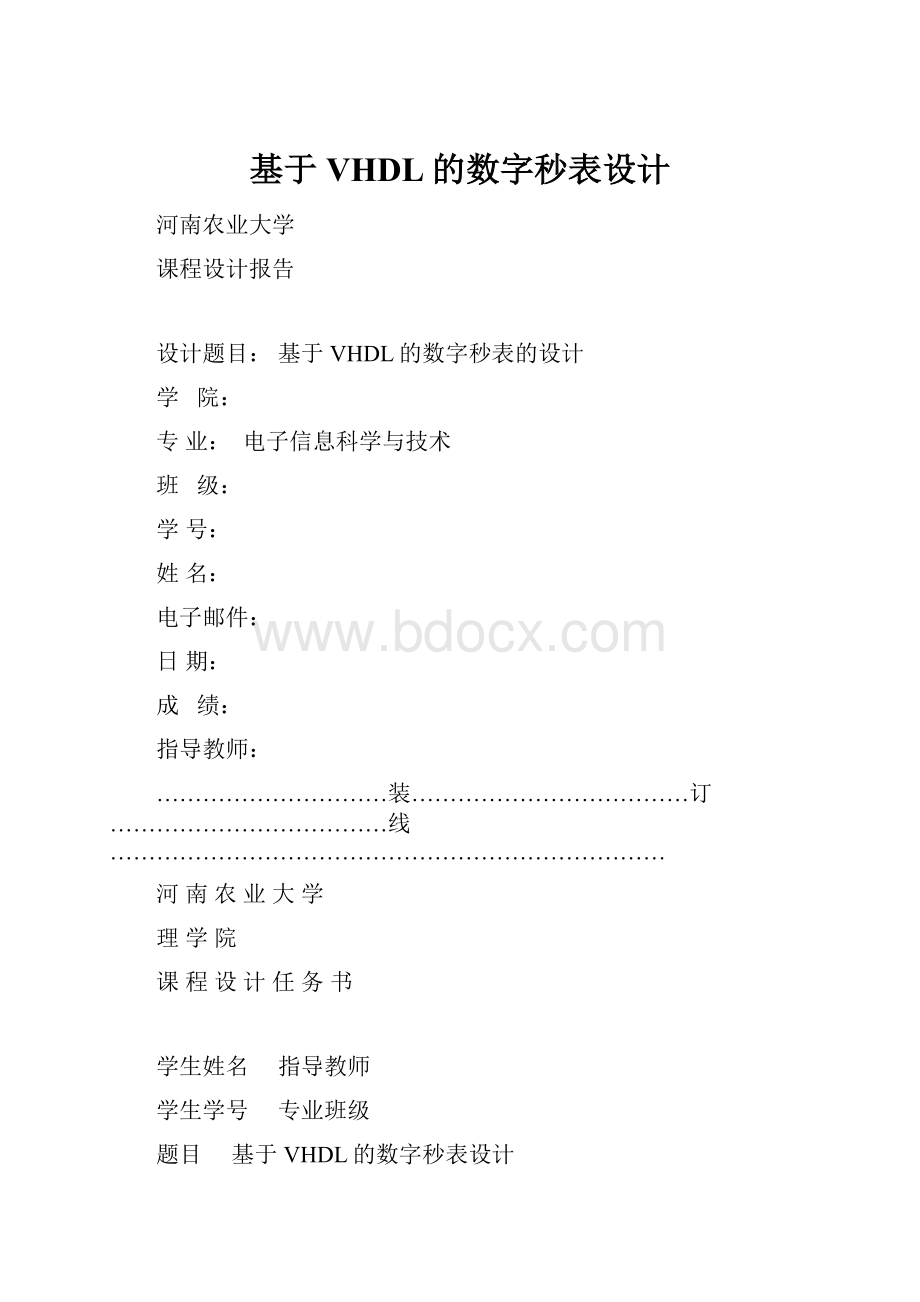 基于VHDL的数字秒表设计.docx
基于VHDL的数字秒表设计.docx
- 文档编号:9455326
- 上传时间:2023-02-04
- 格式:DOCX
- 页数:15
- 大小:222.41KB
基于VHDL的数字秒表设计.docx
《基于VHDL的数字秒表设计.docx》由会员分享,可在线阅读,更多相关《基于VHDL的数字秒表设计.docx(15页珍藏版)》请在冰豆网上搜索。

基于VHDL的数字秒表设计
河南农业大学
课程设计报告
设计题目:
基于VHDL的数字秒表的设计
学院:
专业:
电子信息科学与技术
班级:
学号:
姓名:
电子邮件:
日期:
成绩:
指导教师:
…………………………装………………………………订………………………………线………………………………………………………………
河南农业大学
理学院
课程设计任务书
学生姓名指导教师
学生学号专业班级
题目基于VHDL的数字秒表设计
任务与要求
设计一个数字秒表,主要由显示译码器、分频器、十进制计数器、六进制计数器组成。
在整个秒表中最关键的是如何获得一个精确的100HZ计时脉冲,除此之外,整个秒表还需有一个启动信号和一个归零信号,以便秒表能随意停止及启动。
秒表共有6个输出显示,分别为百分之一秒、十分之一秒、秒、十秒、分、十分,所以共有6个计数器与之相对应,6个计数器的输出全都为BCD码输出,这样便于和显示译码器的连接。
合作人:
分工方案:
开始日期2012年12月3日完成日期2012年月9日
课程设计所在地点
一、数字闹钟设计要求:
1.四个十进制计数器:
分别用来对百分之一秒、十分之一秒、秒和分进行计数;
2.两个六进制计数器:
用来分别对十秒和十分进行计数;
3.分频器;用来产生100Hz计时脉冲;
4.显示译码器:
完成对显示译码的控制。
3、能够完成清零、启动、保持(可以使用键盘或拨码开关置数)功能。
4、时、分、秒、百分之一秒显示准确。
二、实验目的:
1、初步了解可编程逻辑器件(PLD)的基本原理;
2、熟练掌握MAX+PlusⅡ图形编辑器、文本编辑器等不同的输入设计方法,掌握EDA的自顶向下(ToptoDown)的模块化设计思想;
3、了解VHDL语言的语法、句法及结构,能看懂VHDl语言编写的程序,并能熟练运用MAX+PlusⅡ软件对各个程序模块进行波形仿真;
4、熟悉顶层电路的原理图输入法,能应用EDA设计思想进行较复杂系统的分析和设计。
三、设计方案:
按照EDA自顶向下的设计理念,该数字秒表可以分为分频器模块、计数器模块、数据选择和数码管选择模块模块、数码管驱动模块,其顶层电路如下图所示。
四、各个模块的功能:
1、分频器模块:
将2.5MHz的时钟信号转换成100Hz的计时脉冲,使秒表正常工作;
2、计数器模块:
这是本秒表设计的基本功能,对时间进行计数并在显示屏显示当前时间,这个模块中,分别有十进制计数器和六进制计数器,共用四个十进制,分别表示数字秒表的百分之一秒、十分之一秒、秒和分,两个六进制,分别表示数字秒表的十秒和十分;
3、数据选择和数码管选择模块:
通过每个计数器输入的dain信号对数码管进行选择,
4、数码管驱动模块:
通过对输入的信号进行编码,完成对7段数码管的驱动,使数码管显示出对应的数字;
五、系统的各组成部分的原理框图及功能
1、分频器的原理框图:
2、六进制计数器的原理框图:
3、十进制计数器的原理框图:
4、选择模块的原理框图:
5、译码显示电路的原理框图:
其中各部分功能如下:
1、分频器将2.5MHz脉冲变成100Hz。
2、六进制计数器能够实现6进制循环计数。
3、十进制计数器能够实现10进制循环计数。
4、选择模块通过每个计数器输入的dain信号对数码管进行选择
5、译码显示电路通过对输入的信号进行编码,完成对7段数码管的驱动,使数码管显示出对应的数字。
六、系统的主要模块VHDL源程序:
1、分频器源程序clkgen:
libraryieee;
useieee.std_logic_1164.all;
entityclkgenis
port(clk:
instd_logic;
newclk:
outstd_logic);
endentityclkgen;
architectureartofclkgenis
signalcnter:
integerrange0to10#24999#;
begin
process(clk)is
begin
ifclk'eventandclk='1'then
ifcnter=10#24999#thencnter<=0;
elsecnter<=cnter+1;
endif;
endif;
endprocess;
process(cnter)is
begin
ifcnter=10#24999#thennewclk<='1';
elsenewclk<='0';
endif;
endprocess;
endarchitectureart;
2、六进制计数器源程序count6:
libraryieee;
useieee.std_logic_1164.all;
useieee.std_logic_unsigned.all;
entitycount6is
port(clk,clr,start:
instd_logic;
daout:
outstd_logic_vector(3downto0);
cout:
bufferstd_logic);
endcount6;
architecturebehaveofcount6is
signaltemp:
std_logic_vector(3downto0);
begin
process(clk,clr)
begin
ifclr='1'thentemp<="0000";
cout<='0';
elsifclk'eventandclk='1'then
ifstart='1'then
iftemp="0101"thentemp<="0000";
cout<='1';
elsetemp<=temp+1;cout<='0';
endif;
elsifstart='0'thentemp<=temp;cout<=cout;
endif;
endif;
endprocess;
daout<=temp;
endbehave;
3、十进制计数器源程序count10:
libraryieee;
useieee.std_logic_1164.all;
useieee.std_logic_unsigned.all;
entitycount10is
port(clk,clr,start:
instd_logic;
daout:
outstd_logic_vector(3downto0);
cout:
bufferstd_logic);
endcount10;
architecturebehaveofcount10is
signaltemp:
std_logic_vector(3downto0);
begin
process(clk,clr)
begin
ifclr='1'thentemp<="0000";
cout<='0';
elsifclk'eventandclk='1'then
ifstart='1'then
iftemp="1001"thentemp<="0000";
cout<='1';
elsetemp<=temp+1;cout<='0';
endif;
elsifstart='0'thentemp<=temp;cout<=cout;
endif;
endif;
endprocess;
daout<=temp;
endbehave;
4、数据选择和数码管选择模块模块源程序seltime:
libraryieee;
useieee.std_logic_1164.all;
USEieee.std_logic_UNSIGNED.all;
entityseltimeis
port(clr,clk:
instd_logic;
dain0,dain1,dain2,dain3,dain4,dain5:
instd_logic_vector(3downto0);
sel:
outstd_logic_vector(2downto0);
daout:
outstd_logic_vector(3downto0));
endseltime;
architectureaofseltimeis
signaltemp:
integerrange0to5;
begin
process(clk)
begin
if(clr='1')then
daout<="0000";
sel<="000";
temp<=0;
elsif(clk='1'andclk'event)then
iftemp=5thentemp<=0;
elsetemp<=temp+1;
endif;
casetempis
when0=>sel<="000";daout<=dain0;
when1=>sel<="001";daout<=dain1;
when2=>sel<="010";daout<=dain2;
when3=>sel<="011";daout<=dain3;
when4=>sel<="100";daout<=dain4;
when5=>sel<="101";daout<=dain5;
endcase;
endif;
endprocess;
enda;
5、数码管驱动源程序ym:
libraryieee;
useieee.std_logic_1164.all;
entityymis
port(num:
instd_logic_vector(3downto0);
led:
outstd_logic_vector(6downto0));
endym;
architectureaofymis
begin
process(num)
begin
casenumis
when"0000"=>led<="0111111";
when"0001"=>led<="0000110";
when"0010"=>led<="1011011";
when"0011"=>led<="1001111";
when"0100"=>led<="1100110";
when"0101"=>led<="1101101";
when"0110"=>led<="1111101";
when"0111"=>led<="0100111";
when"1000"=>led<="1111111";
when"1001"=>led<="1101111";
whenothers=>led<="0000000";
endcase;
endprocess;
enda;
6、数字秒表的源程序chengpin
libraryieee;
useieee.std_logic_1164.all;
useieee.std_logic_arith.all;
useieee.std_logic_unsigned.all;
entitychengpinis
port(
stop,clk,clk2,start:
instd_logic;
sel:
outstd_logic_vector(2downto0);
a,b,c,d,e,f,g:
outstd_logic;
);
endchengpin;
architecturecofchengpinis
componentcount10
port(
clk,clr,start:
instd_logic;
daout:
outstd_logic_vector(3downto0);
cout:
outstd_logic);
endcomponent;
componentcount6
port(
clk,clr,start:
instd_logic;
daout:
outstd_logic_vector(3downto0);
cout:
outstd_logic);
endcomponent;
componentseltime
port(
clr,clk:
instd_logic;
dain1:
instd_logic_vector(3downto0);
dain2:
instd_logic_vector(3downto0);
dain3:
instd_logic_vector(3downto0);
dain4:
instd_logic_vector(3downto0);
dain5:
instd_logic_vector(3downto0);
dain6:
instd_logic_vector(3downto0);
sel:
outstd_logic_vector(2downto0);
daout:
outstd_logic_vector(3downto0));
endcomponent;
componentclkgen
port(clk:
instd_logic;
newclk:
outstd_logic);
endcomponent;
componentym
port(num:
instd_logic_vector(3downto0);
led:
outstd_logic_vector(6downto0));
endcomponent;
componentcfq
port(
clk,d:
instd_logic;
y:
outstd_logic);
endcfq;
begin
signalcount_cout:
std_logic_vector(6downto0);
signaldaout1,daout2,daout3,daout4,daout5,daout6,daout7:
std_logic_vector(3downto0);
signalledout:
std_logic_vector(6downto0);
begin
a=>ledout(0);b=>ledout
(1);c=>ledout
(2);d=>ledout(3);e=>ledout(4);f=>ledout(5);g=>ledout(6);
u1:
count10portmap(clk,stop,start,daout1,count_cout(0));
u2:
count10portmap(count_cout(0),stop,start,daout2,count_cout
(1));
u3:
count10portmap(count_cout
(1),stop,start,daout3,count_cout
(2));
u4:
count6portmap(count_cout
(2),stop,start,daout4,count_cout(3));
u5:
count10portmap(count_cout(3),stop,start,daout5,count_cout(4));
u6:
count6portmap(count_cout(4),stop,start,daout6,count_cout(5));
u7:
cfqportmap(clk2,count_cout(5),count_cout(6));
u7:
seltimeportmap(stop,clk,daout1,daout2,daout3,daout4,daout5,daout6,sel,daout7);
u8:
ymportmap(daout7,ledout);
u9:
clkgenportmap(clk,newclk);
endc;
六、程序功能仿真图:
1、count6仿真图如下示:
2、count10仿真图如下示:
3、seltime仿真图如下示:
4、ym仿真图如下示:
七、心得和体会
通过这次课程设计使我懂得了理论与实际相结合是很重要的,只有理论知识是远远不够的,只有把所学的理论知识与实践相结合起来,从理论中得出结论,才能真正为社会服务,从而提高自己的实际动手能力和独立思考的能力。
总的来说,这次设计的数字秒表还是比较成功的,虽然在实际的过程中曾经遇到了大量的问题,但是经过自己的努力,都给妥善解决了,这样的积累对于现在大学生来说是十分宝贵的。
希望以后能有更多的动手实践机会,在硬件中发现自己的不足,弥补自己的不足,最终成为一个合格的大学生。
最后,特别感谢老师对我的帮助。
八、参考文献
[1]谭会生、张昌凡.EDA技术及应用.西安电子科技大学出版社,2006
[2]东方人华.MAX+PLUS
入门与提高.清华大学出版社,2004
EDA设计实习成绩评定表
评定项目
内容
满分
评分
总分
学习态度
学习认真,态度端正,遵守纪律
10
答疑和设计情况
认真查阅资料,勤学好问,提出的问题有一定的深度,分析解决问题的能力教强。
40
说明书质量
设计方案正确、表达清楚;设计思路、实验(论证)方法科学合理;达到课程设计任务书规定的要求;图、表、文字表达准确规范,上交及时。
40
回答问题情况
回答问题准确,基本概念清楚,有理有据,有一定深度。
10
总成绩
采用五级分制或百分制。
五级分制:
优、良、中、及格、不及格
指导教师评语:
签名:
年月日
- 配套讲稿:
如PPT文件的首页显示word图标,表示该PPT已包含配套word讲稿。双击word图标可打开word文档。
- 特殊限制:
部分文档作品中含有的国旗、国徽等图片,仅作为作品整体效果示例展示,禁止商用。设计者仅对作品中独创性部分享有著作权。
- 关 键 词:
- 基于 VHDL 数字 秒表 设计
 冰豆网所有资源均是用户自行上传分享,仅供网友学习交流,未经上传用户书面授权,请勿作他用。
冰豆网所有资源均是用户自行上传分享,仅供网友学习交流,未经上传用户书面授权,请勿作他用。


 1212中级汽车维修工考试试题三.docx
1212中级汽车维修工考试试题三.docx
